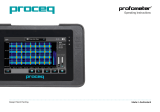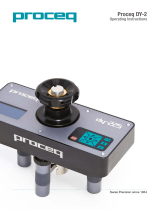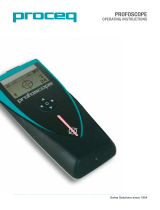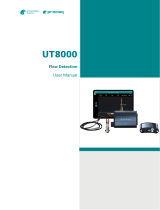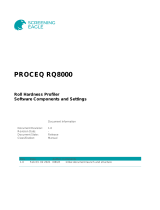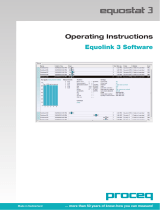Page is loading ...

PM8500
Quick Reference

Keys -Overview
Device ON/OFF
Medium push
(3s)
Power ON
Medium push
(3s)
Power OFF
Taking out the
Battery
Reboot device
USB-C
Port Top Button
Battery
BT dongle
Ground cable
connector
Potential cable (all
electrodes)
Encoder cable
(wheel electrodes)

LED - Behaviour
LED
port LED behaviour
Battery Status –While
turning on the device
Green: single quick blink: >20%
Red: single quick blink: <20%
Turn on, awaiting Bluettoh
connection
Green Solid
Connected. Review Mode
•Paused
•Stopped
Blue Solid
While measuring
(rod/wheels)
Blue Blinking
Turn Off No changes on LED during first 1sec, then Red Solid
countdown during 1 sec
Errors
Device in boot loader
mode
Red-Green Alternate Blinking

Measurement Principle
Half Cell
Potential
-Under normal conditions reinforcement steel is protected from corrosion by a thin, passive film of hydrated iron oxide
-This passive film is decomposed due to the reaction of the concrete with atmospheric carbon dioxide (CO2, carbonatation),
or by the penetration of substances aggressive to steel, in particular chlorides.
-At the anode, ferrous ions (Fe++) are dissolved, and electrons are set free. These electrons drift through the steel to the
cathode, where they form hydroxide (OH-) with the generally available water and oxygen. This principle creates a potential
difference that can be measured by the half-cell method.
-The basic idea of potential measurement is to measure the potentials at the concrete surface. For this purpose, a Cu/CuSO4
reference electrode (with a known potential) is connected via a high-impedance voltmeter to the steel reinforcement and is
moved in a grid over the concrete surface.

Typical Reference Values
Half Cell
Potential
-Typical orders of magnitude (for information only) for the half-cell potential of steel in concrete measured against a
Cu/CuSO4 reference electrode are in the following range (RILEM TC 154-EMC)
RILEM TC 154-EMC
Water saturated concrete
without O2 -1000 to -900 mV
Moist, chloride contaminated
concrete
-600 to -400 mV
Moist, chloride free concrete -200 to +100 mV
Moist, carbonated concrete -400 to +100 mV
Dyr, carbonated concrete 0 to +200 mV
Dry, non-carbonated
concrete 0 to +200 mV
-Probability of corrosion rises with low (negative) potentials. Active corrosion can be expected at locations where a
negative potential is surrounded by increasingly positive potentials. I.e. locations with a positive potential gradient.
Potential differences of around +100mV within a 1m distance, together with negative potentials, can be a clear
indication of active corrosion
-The actual potential absolute value (corrosion threshold) may vary on different structures.
-ASTM C 876-09 suggests two different thresholds:
ASTM C 876-09
90% probabiliy of corrosion < -350mV
Uncertain -350 to -200 mV
90% probability of no
corrosion > -200mV

External Factors
Half Cell
Potential
Moisture
Moisture has a large effect on the
measured potential leading
to more negative values
Cover
The potential becomes more positive
with increasing concrete cover.
Very low concrete cover can lead
to more negative potentials which
would seem to indicate high levels
of corrosion
Electrical resistivity
Low electrical resistivity leads to
more negative potentials and the
potential gradients become flatter –
coarse grid is needed.
High electrical resistivity leads to
more positive potentials and
potential gradients become steeper
–fine grid is needed.
Temperature
High temperature will cause
concrete resistivity to be lower and low
temperature will cause concrete
resistivity to be higher
O2
Oxygen content
With decreasing oxygen concentration
and increasing pH-value at a steel
surface its potential becomes more
negative

Preliminary operations
Prepare the
electrodes
Copper
Sulphate*
Connect to rebar
Rod Electrode: Remove the cap with the wooden plug and soak it into
water for about an hour to allow the wood to saturate and swell.
*When handling copper sulphate be careful to take note of the safety instructions on the packaging
Wheel Electrode: The wooden plug is not intended to be removed.
Immerse the wheel in water for an hour to allow the water to soak into the
plug. Only the wheels should be immersed, therefore, please remove them
from the legs before doing it.
The felt hoops and the felt hoop connector must be saturated before
measuring. In normal use (with water and cupper solution), the thin felt is
on the wooden spigot side.
The water should be dripping out slowly from the water tank throughout
the 1mm nozzle (red mark). The bike valve should provide a high pressure;
if water is dripping out from this valve, please apply some pressure
blowing with your mouth.
Prepare the saturated solution by mixing 40 units by weight of copper
sulphate with 100 units by weight of distilled water. Add an additional
teaspoon of copper sulphate crystals into the electrode.
The electrode should be filled as completely as possible with a minimum
of air in the compartment. This ensures that the solution is in contact with
the wooden plug even when measuring in an upwards direction.
The ground cable must be connected to the reinforcement. The connection
should be made with the least possible resistance –grind it and connect
cable with welding tongs.
The connection should be tested for continuity. This requires at least one
other point of the reinforcement to be exposed and to check the resistance
between the two with an Ohmmeter -not more than 1 Ω above the
resistance of the cable used.
A secure connection can be also obtained by drilling a 25 mm hole into the
concrete above the rebar, then drill a 4 mm hole into the rebar and insert a
self tapping screw with attached lead into the hole in the steel

Preliminary operations
Coated surfaces
Pre-moistening The contact between the pore solution of the concrete and the probe can be impaired by a
dried out concrete skin. This can greatly increase the electrical resistivity of the concrete.
It is recommended to moisten the surface approximately 10 to 20 minutes before carrying
out the measurement.
If this is not possible, it must be ensured that the sponge on the Rod Electrode or the felt
hoops on the wheel electrode are sufficiently moistened. In this case, when making a
measurement, the probe must be held against the surface until a stable end value is
reached. This is only possible with the Rod Electrode.
In the case of the wheel electrode with its continual automatic measurement, it is not
possible to monitor whether or not the measured value is stable. Therefore, it is
recommended to pre-moisten the surface in sections and to measure in intervals of a few
minutes.
It is not possible to make a measurement through an electrically isolating coating (e.g. an
epoxy resin coating, sealing sheets or asphalt layers.)
It is possible to make a measurement through thin dispersion coatings, however this can
cause a small shift of the potentials. To do this, potentials should be measured at a few
locations
• in the first place through the coating and
• with the coating removed
If there is no alteration of the potential, or if a shift of the potential can be compensated
by a correction (e.g. V = ±50 mV), then a measurement can be made directly on the
coating. If not, then the coating must be removed before making the measurement.

Maintenance and Cleaning
Rod Electrode
Wheel Electrode -Remove the felt hoops and wash in lukewarm water.
-Remove the plastic filling screw and pour the copper sulphate solution into a
container. (This can be reused)
-Flush out several times with water.
-Dissolve 1-part citric acid in 10 parts hot water and half fill the wheel.
-Replace the filling screw.
-Leave for 6 hours, shaking occasionally.
-Pour out the citric acid solution (no special disposal procedure is required) and flush
out several times with water.
-Refill the electrode with copper sulphate solution.
-Replace the felt hoops. The felt hoop connector must be in place between the
dampening nozzle and the wooden plug of the wheel electrode.
-When not in use, store the wheel electrode with the wooden plug facing upwards.
-Unscrew the two caps, wash with water and carefully clean the inner side of the tube.
-Clean the copper rod using emery cloth.
-Refill the electrode with copper sulphate
To guarantee consistent, reliable and accurate measurements, the instrument should be calibrated on a yearly basis. The
customer may, however, determine the service interval based on his or her own experience and usage.
-Do not immerse the instrument in water or other fluids.
-Keep the housing clean at all times.
-Wipe off contamination using a moist and soft cloth.
-Do not use any cleaning agents or solvents.
-Do not open the housing of the instrument yourself.

Settings
Expand Grid
Limits
Define Cell
Dimensions
Change
measuring
direction
Start / Stop
measurement
File Name
Live Potential
Measuring Mode:
Basic / Advanced
Probe Type:
Rod, one wheel,
four wheel
Half Cell Solution:
Cu/CuSO4, Ag/AgCl,
Hg/Hg2Cl2
Settings Panel
Logbook
Auto Save Values
Only for rod electrode
Units: Metric and
Imperial
Threshold
Standard:
ASTM, Custom –
Only for Basic Mode
Potential
View Color
Range
Change
Color Palette

Settings
Potential
View Color
Range
Change
Color Palette
Define Cell
Dimensions
Change
measuring
direction
Expand Grid
Limits
Start / Stop
measurement
File Name
Live Potential Settings Panel
Logbook
Concrete
Temperature
Auto potential
Shift: If yes, it
assigns the drift
associated to the
temperature. If not, it
assign the manual
value
Potential Values:
Show potential values on
the grid (Yes/No)
Aspect Ratio:
Aspect ratio 1:1 of cells
(Yes / No)
Grid Lines:
Show grid lines (Yes/No)
Auto Save Delay:
Modify the waiting time
between measurements

Potential Map
The potential map provides
an area mappingof the
measured potential values
The cells where no potential
value was measured are
displayed in black
Zoom and scroll to any
desired location, change the
color palette and the
potential thresholds to
enhance the readability and
highlight the desired details.
Text notes can be added to
any cells

Statistic View
Distribution and cumulative
distribution are shown in the
same view.
On the horizontal axis, the
potential values are displayed;
the vertical bars show the
percentage of the respective
potential values measured and
stored.
In the upper part, the median,
standard deviation, minimum and
maximum values are shown,
together with the number of
measurements.
If the surface under test has both
actively corroding as well as
passive rebars, then the two
states exhibit two distinct
partially overlapping
distributions, with the corroding
areas centered on amore
negative potential.

Statistic View
The cumulative distribution graph is
used to determine the active and the
passive potential thresholds that will
affect the Chipping Graph,
discriminating actively corroding
areas from passive areas where no
corrosion is to be expected.
If the surface under test has both
actively corroding as well as passive
rebars, then the curve will typically
exhibit a central region with alower
gradient (flatter). The two points
where the gradient changes can be
marked on the screen by dragging the
two vertical cursors.
The red cursor will define the
maximum (most positive) potential
value expected of the active
distribution.Active corrosion is to be
expected in the region of the left hand
(more negative) straight section.
The green cursor will define the
minimum (most negative) potential of
the passive distribution.

Chipping Graph
The Chipping Graph View provides an
area mapping of the measured
potential values with afixed
green/yellow/red color palette
referring to the thresholds set in the
Cumulative Distribution View.
An immediate overview is then
provided discriminating the actively
corroding areas (red) from the
passive areas (green) and the
uncertain regions (yellow).

Basic Mode
The Basic Mode shows directly the Chipping Graph at the same time as the measurement is done.
For that purpose, the threshold limits have to be preset:
-Manually
-Selecting the ones included in the ASTM C876-09,Appendix X1, assigning a 90%probability of corrosion ongoing to the
areas more negative than -350 mV, and a 90%probability of no corrosion to the areas more positive than -200 mV.

Advanced Mode
The Advanced Mode is recommended for expert users that want to create their own threshold limits based on the total measured
values.
The process is the following: Potential map Statistic View Setting the threshold limits Chipping Graph


For more information on the product use of the product,
please refer to the Profometer PM8500 documentation
It is available for download on
For safety and liability information, please download at https://www.screeningeagle.com/en/about-us/gtc-and-certificates
Subject to change. Copyright © 2023 by Proceq SA, Schwerzenbach. All rights reserved.
www.screeningeagle.com/en/products/profometer-pm8500

ASIA-PACIFIC
Proceq Asia Pte Ltd.
1 Fusionopolis Way
Connexis South Tower #20-02
Singapore 138632
T +65 6382 3966
CHINA
Proceq Trading Shanghai Co., Limited
Room 701, 7th Floor, Golden Block
407-1 Yishan Road, Xuhui District
200032 Shanghai | China
T +86 21 6317 7479
EUROPE
Proceq AG
Ringstrasse 2
8603 Schwerzenbach
Zurich | Switzerland
T +41 43 355 38 00
UK
Screening Eagle UK Limited
Bedford i-lab, Stannard Way
Priory Business Park
MK44 3RZ Bedford
London | United Kingdom
T +44 12 3483 4645
MIDDLE EAST AND AFRICA
Proceq Middle East and Africa
Sharjah Airport International
Free Zone | P.O.Box: 8365
United Arab Emirates
T +971 6 5578505
USA, CANADA & CENTRAL AMERICA
Screening Eagle USA Inc.
14205 N Mopac Expressway Suite 533
Austin, TX 78728 | United States
Screening Eagle USA Inc.
117 Corporation Drive
Aliquippa, PA 15001 | United States
T +1 724 512 0330
SOUTH AMERICA
Proceq SAO Equipamentos
de Mediçao Ltda.
Rua Paes Leme 136
Pinheiros, Sao Paulo
SP 05424-010 | Brasil
T +55 11 3083 3889
ScreeningEagle.com
Version 0
/
